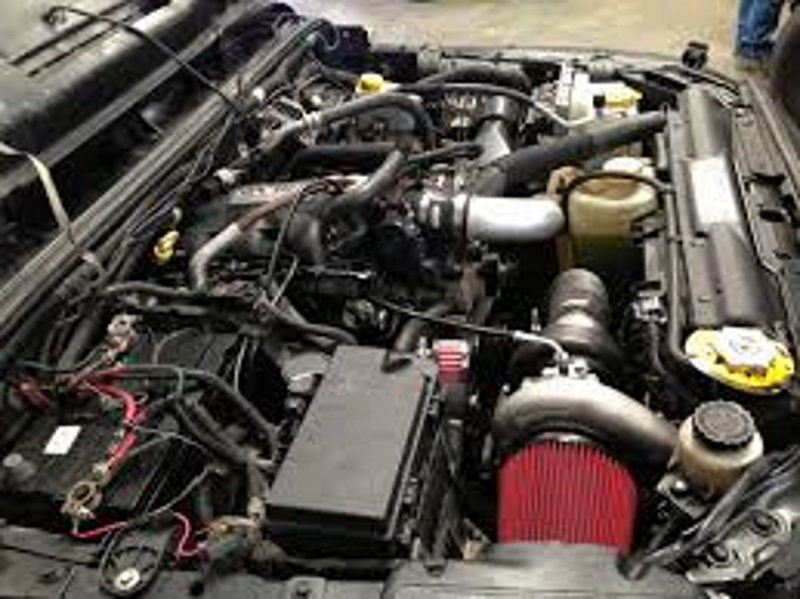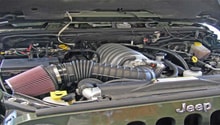Jeep Wrangler JK: Engine Performance Modification
The JK is a platform with its roots developed to conquer rough terrain. Although capable from the factory, it's great to have the option to bump up the power.
This article applies to the Jeep Wrangler JK (2007-Present).
The JK uses two engines from the factory (3.8 liter and 3.6 cylinder). Both of these engines produce substantial horsepower and torque, but the factory levels may not be enough for the owner with towing and off-road needs. Bolt-on performance parts, such as a intake and exhaust, may give you a slight increase in power levels, but the real performance comes with forced induction and reliable computer programming.
Engine Performance Modifications
Engine performance modifications range from basic bolt-on upgrades to forced induction, such as superchargers and turbos. With the right modifications, you'll extract more horsepower as well as torque, and possibly improve your fuel economy. Whether on-road or off-road, bumping your engines power levels from 25% to %75 over stock will leave plenty of power at your disposal.

Cold Air Intake

DIY Cost – $100-$400
Professional Cost – $75-$150 for labor
Skill Level – Easy; the majority of kits are direct bolt-on in a few steps.
A quality cold air intake changes both the intake tubing type and air filter. The JK is equipped with a rubber hose from the factory. These hoses are good for manufacturing (cost-effective to produce), but easily allow engine heat to raise intake air temperatures; this reduces power. In addition, the factory paper air filter is replaced with a high flowing filter usually of the cone style for more filter surface area. You have many options when buying a cold air intake, such as Mopar, AFE, Injen, Airraid, and RedRock, among others.
Cat-Back Exhaust

DIY Cost – $150-$500
Professional Cost – $100-$200
Skill Level – Moderate; most kits are direct bolt-in. Installation will be much easier with a second person.
Cat-back exhaust systems improve exhaust flow and increase sound without effecting your mandated emissions systems. Because the piping starts after the catalytic converter, you wont need an aftermarket tune to disable check engine lights that may be associated with a off-road only exhaust. Companies create these kits using the factory mounting locations while reducing bends and increasing pipe diameters. One downside to increased piping diameter is reduced clearance for off-road use. This is why some companies engineer these systems with clearance in mind and re-route the exhaust path closer to the vehicle body. Some popular choices for cat-back exhaust systems include MBRP, JK Pypes, Gibson, and Dynomax.
Tuner

DIY Cost – $100-$500
Professional Cost – $100 or less for labor (does not include dyno tuning)
Skill Level – Easy; most tuners simply plug in to your OBD-II port.
Tuners do more than just extract horsepower and torque. With so many systems computer-controlled on your JK, a tuner can now calibrate your speedometer for rear axle gear changes or increase engine idle to improve winching power. Tuners such as the Superchips Traildash can store multiple tunes that optimize performance/fuel economy during highway driving, towing, and off-road. These tunes adjust fuel and ignition mapping, as well as transmission shift points. Most come included with multiple performance tunes such as the Diablosport Trinity, but maximum gains in power and fuel economy can be achieved with a proper dyno tune by a reputable Jeep JK tuner.
Forced Induction

DIY Cost – $4,000-$6,000
Professional Cost – $800-$1,200 for labor
Skill Level – Hard; these kits involve lengthy installation procedures. Some modification and fabrication could be required.
Other than nitrous oxide, superchargers and turbochargers are the number one way to increase your engines power. There are advantages and disadvantages to each. A supercharger is belt-driven by the power from the crankshaft. This effect reduces horsepower by increasing the amount of mass the engine must turn while operating. Depending on your goals (instant torque), the reduced power out of boost may not outweigh the instant increase in power once the throttle is applied. A turbo charger is driven by the intake air charge and multiplies its effect. The disadvantage is turbo lag. This is the period where the turbo is spinning to slowly to compress the intake air. There are several companies producing superchargers, such as RIPP, Edelborck, Magnuson and Sprintex. TRE performance offers a procharger option for the 3.6 liter engine. Turbo kits are more limited. Prodigy Performance offers two turbo kit levels, increasing power levels almost 100% over stock!
Hemi Engine Conversion

DIY Cost – $6,350
Professional Cost – $3,000-$5,000 for labor
Skill Level – Hard; this swap involves a detailed, lengthy installation procedure. Some modification and fabrication may be required.
For some, the factory six cylinder engines aren't enough. Thanks to the AEV Hemi Conversion Kit, your now able to install a Hemi 5.7 liter or 6.4 liter engine into your JK. The kit includes tons of swap components, such as motor and transmission mounts, wiring harness, and A/C lines to make your swap feel like a factory option. The Hemi engines make big power with the 6.4 liter producing 470 hp and 470 ft/lbs of torque. For an added bonus, forced induction options are easy to find for these engines.
Related Discussions
- Engine Mods - JK-Forum.com
- 3.6L Performance Modifications - JK-Forum.com
- 3.8L Engine Performance Upgrades - JK-Forum.com






